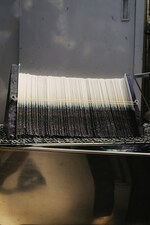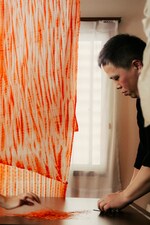KAZUKI TABATA:
THE ART OF SHIBORI


Captivated by the limitless potential of Japanese shibori, artisan Kazuki Tabata discusses the importance of preserving traditional craftsmanship, and the serendipity of his collaboration with COS
Shibori, the Japanese term meaning to squeeze or wring, originates from the simple practice of resist-dyeing to create a mesmerising array of colours, designs and patterns.
Emerging in Japan during the 8th century, its popularity grew exponentially in the city of Kyoto, in the country’s largest island of Honshu, where clean water and large surrounding rivers are said to have inspired many of its residents to start local shibori workshops. Centuries later, that includes Mr Kazuki Tabata (he/him), who prides himself on practicing Kyoto’s distinctive hand-dyeing methods through his maison, Tabata Shibori.
A former salaryman specialising in sound engineering, Kazuki began his career in shibori after the passing of his uncle who worked in the family business as a traditional craftsman, which the Ministry of Economy, Trade and Industry certifies after at least 12 years of experience and succeeding written and practical exams. Kazuki, meanwhile, self-taught using the dyeing tools that were nearly thrown away, applying the technical skills of his formative studies in sound and lighting, its disciplines and aspects of collaboration, to inform his shibori creations.
‘TRADITIONAL CRAFTS CARRY STORIES AND SIGNIFICANCE IN THEIR PROCESSES. WE NEED TO EDUCATE MORE PEOPLE TO APPRECIATE THE ARTISTRY.’








With a determination to preserve age-old techniques, Kazuki dedicates extensive hours to hand-dyeing, creating patterns using entirely manual processes by way of Bosen (防染), a resist-dye method achieved by binding fabric with threads, wrapping it with plastic, clamping it between boards, or gathering wrinkles to create areas where the dye is resisted. ‘These processes are often overlooked’, Kazuki says. ‘Traditional crafts carry stories and significance in their processes, and I believe there is a need to educate more people about this aspect to shift the demand towards appreciating the artistry behind each piece.
Kazuki describes the compatibility between shibori dyeing and fabric as ‘necessary’, often favouring fibres such as cotton, linen and silk with character and depths best suited for effective dye penetration. Distinguished by the patterns or forms created from tying fabric, Kazuki specialises in methods such as kasa maki shibori, which resembles a wrapped umbrella, boshi shibori, resembling a hat, yukihana shibori, resembling snowflakes, and a unique technique known as tako boshi shibori, where the tied shape resembles an octopus. The dyes draw from traditional Japanese colours and hues found in nature throughout the four seasons.
In committing his life to shibori, Kazuki promises to preserve it for the future. ‘In an age where machines and computers can accomplish almost anything, it is precisely because of this convenience that I feel compelled to preserve shibori dyeing for future generations’, he says. And while Japan boasts the world’s oldest history, Kazuki welcomes the digital age. ‘Through social media platforms, many people learn about shibori dyeing. I believe tradition evolves while adapting to the times.'
To discover more, we caught up with Kazuki to learn about the traditions of shibori and the beauty of his exclusive artworks across womenswear, menswear and accessories, in collaboration with COS.


‘IN AN AGE WHERE MACHINES AND COMPUTERS CAN ACCOMPLISH ALMOST ANYTHING, CONVENIENCE COMPELS ME TO PRESERVE SHIBORI DYEING FOR FUTURE GENERATIONS.’
SHIBORI BEGINNINGS
‘As artisans age and the demand for shibori dyeing declines, often there’s no natural successor. After my father’s uncle, who had his own shibori business, passed away, my aunt planned on disposing of his shibori dyeing tools. I felt it was a waste. Once people and traditions are lost, it’s over, there’s no going back. I thought, “If no one else will do it, then I should". I asked my aunt not to throw away those tools. From then on, I started working as a shibori artisan.’
THE PROCESS
‘Shibori dyeing involves entirely manual processes, limiting the quantity that can be produced by a single person and resulting in each piece being a unique work of art. However, these processes are often overlooked, leading to the expectation for shibori to be treated like mass-produced items manufactured by machines, with demands for low cost and high volume. Traditional crafts carry stories and significance in their processes, and I believe there is a need to educate more people about this aspect to shift the demand towards appreciating the artistry behind each piece.’








PRESERVING TRADITION
‘Tradition encompasses the wisdom, techniques, trial and error, and fervent desires of our predecessors who have been involved in it throughout history. Shibori dyeing embodies the wrinkles and dye that can only be created by human hands, carrying with them the sentiments of never forgetting the importance of caring for others. In an age where machines and computers can accomplish almost anything, it is precisely because of this convenience that I feel compelled to preserve shibori dyeing for future generations.’
SERENDIPITY
‘For this collection, we utilised two techniques: "yukihana shibori" (snowflake shibori) and "tesuji shibori" (hand-stitched shibori). Both techniques rely on serendipitous dyeing methods, meaning we don't know what the pattern will look like until the shibori is unravelled. We dyed and redyed the fabric multiple times until the desired pattern emerged throughout the entire piece.’
COLLABORATION
‘It was an extraordinary experience to be part of a team where everyone works diligently behind the scenes. In the world of shibori, each piece handmade by an individual is limited to just a few. These pieces often don’t reach beyond Japan or Kyoto but through our collaboration with COS, I am thrilled that shibori will be showcased to people all over the world. That, to me as a creator, is the greatest joy.’


‘SHIBORI EMBODIES THE WRINKLES AND DYE THAT CAN ONLY BE CREATED BY HUMAN HANDS.’
QUICKFIRE QUESTIONS
COS
Where to visit in Kyoto?
KT
Keihoku, Ayabe, Hiyoshi and Miyama to experience the four seasons
COS
What music do you play in the studio?
KT
Anime theme songs, old and new
COS
Favourite Japanese film?
KT
Doraemon: Nobita’s New Dinosaur
COS
How would you describe your son?
KT
A source of strength